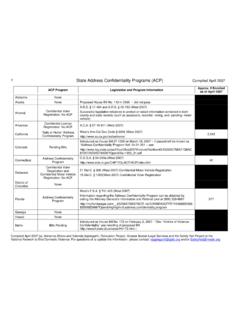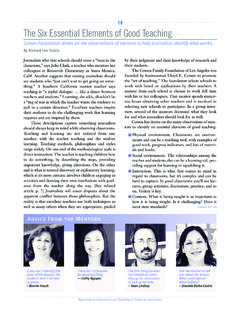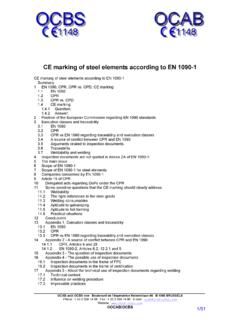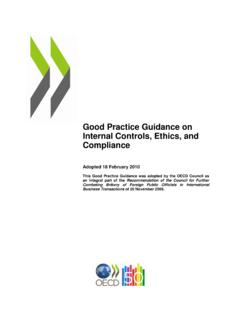Transcription of Community Policing Principles and Elements handout
1 Community Policing : Principles and Elements Gary Gordner Eastern Kentucky University Community Policing has its roots in such earlier developments as police- Community relations, team Policing , crime prevention, and the rediscovery of foot patrol. In the 1990s it has expanded to become the dominant strategy of Policing so much that the 100,000 new police officers funded by the 1994 Crime Bill must be engaged in Community Policing . Community Policing (COP) is often misunderstood. Four essential Principles should be recognized: COP is not a panacea. It is not the answer to all the problems facing any one department. However, COP is an answer to some of the problems facing modern Policing and it may be an answer to some of the problems facing any one department. COP is not totally new. Some police departments or individual police officers report that they are already doing it, or even that they have always practiced COP. This may be true. Even so, there are some specific aspects of Community Policing that are relatively new; also, very few agencies can claim that they have fully adopted the entire gamut of COP department-wide.
2 COP is not hug a thug. It is not anti-law enforcement or anti-crime fighting. It does not seek to turn police work into social work. In fact, COP is more serious about reducing crime and disorder than the superficial brand of incident-oriented 911 Policing that most departments have been doing for the past few decades. COP is not a cookbook. There is no ironclad precise definition of Community Policing nor a set of specific activities that must always be included. A set of universally applicable Principles and Elements can be identified, but exactly ho they are implemented should and must vary from place to place, because jurisdictions and police agencies have differing needs and circumstances. In order to describe the full breadth of Community Policing , it is helpful to identify four major dimensions of COP and the most common Elements occurring within each. The four dimensions are: The Philosophical Dimension The Strategic Dimension The Tactical Dimension The Organizational Dimension Community Policing : Principles and Elements 1996.
3 Page 1 of 11. The Philosophical Dimension Many of its most thoughtful and forceful advocates emphasize the Community Policing is a new philosophy of Policing , perhaps constituting even a paradigm shift away from professional-model Policing and not just a particular program or specialized activity. The philosophical dimension includes the central ideas and beliefs underlying Community Policing . Three of the most important of these are citizen input, broad function, and personal service. (1) Citizen Input Community Policing incorporates a firm commitment to the value and necessity of citizen input to police policies and priorities. In a free and democratic society, citizens are supposed to have a say in how they are governed. Police departments, like other agencies of government, are supposed to be responsive and accountable. Also, from a more selfish standpoint, law enforcement agencies are most likely to obtain the citizen support and cooperation they need when they display interest in input from citizens.
4 A few of the techniques utilized to enhance citizen input are: Agency Advisory Boards groups of citizens who meet regularly with the chief/sheriff and other top commanders to provide input and advice on overall agency policies, priorities, and issues. Unit Advisory Boards groups of citizens who meet regularly with unit commanders and related personnel to provide input and advice on unit policies, priorities, and issues ( precinct advisory boards, victim/witness advisory councils, family abuse advisory boards, etc.). Beat Advisory Boards groups of citizens who meet regularly with their beat officer or beat team to provide input and advice about priorities and issues. Special Advisory Boards groups of citizens with special interests who meet regularly with the chief/sheriff, top commanders, or related personnel to provide input and advice on policies, priorities, and issues related to their special interests ( ministry alliance, business council, mental health council, etc.)
5 Community Surveys surveys conducted in various ways (telephone, mail, in-person, in the newspaper, etc.) to obtain citizen views on policies, priorities, and issues. Electronic Mail/Home Page use of the Internet, on-line services, computer bulletin boards, etc., to obtain citizen views on policies, priorities and issues. Radio/Television Call-In Shows use of radio and TV call-in shows to obtain citizen views on policies, priorities and issues. Town Meetings public meetings to which citizens are invited in order to provide input and advice on policies, priorities, and issues. (2) Broad Function COP recognizes Policing as a broad function, not a narrow law enforcement or crime fighting role. The job of police officers is seen as Community Policing : Principles and Elements 1996. Page 2 of 11. working with residents to enhance neighborhood safety. This includes resolving conflicts, helping victims, preventing accidents, solving problems, and fighting fear as well as reducing crime through apprehension and enforcement.
6 Policing is inherently a multi-faceted government function arbitrarily narrowing it to just call-handling and law enforcement reduces its effectiveness in accomplishing the multiple objectives that the public expects police to achieve. Some examples of the broad function of Policing include: Traffic Safety good police departments pursue traffic safety through education and engineering as well as selective enforcement. Drug Abuse many agencies eek to reduce drug abuse through public education, DARE, regulation of prescriptions, and control of chemicals as well as through a variety of enforcement efforts. Fear Reduction many agencies attempt to reduce fear of crime (especially when it is out of proportion to actual risk) through public education, high-interaction patrol, problem solving, and enforcement focused on nuisance crimes ( , panhandling and loitering). Domestic Violence most police departments now offer domestic violence victims an array of services (referral, transportation, protection, probable cause arrest, etc.)
7 Rather than merely explaining how to obtain an arrest warrant. Zoning some agencies take the opportunity to participate in zoning decisions and related matters ( , issuance of building permits) in order to offer input related to traffic safety, crime prevention, etc. (3) Personal Service Community Policing emphasizes personal service to the public, not bureaucratic behavior. This is designed to overcome one of the most common complaints that the public has about government employees, including police officers that they do not seem to care, and that they treat citizens as numbers, not real people. Of course, not every police-citizen encounter can be amicable and friendly. But whenever possible, officers should deal with citizens in a friendly, open, and personal manner designed to turn them into satisfied customers. This can be best done by eliminating as many artificial bureaucratic barriers as possible, so that citizens can deal directly with their officer. A few of the methods that have been adopted in order to implement personalized service are: Officer Business Cards officers are provided personalized business cards to distribute to victims, complainants, and other citizens with whom they have contact.
8 Officer Pagers and Voice Mail officers have their own pagers and voice mail so that victims, complainants, and other citizens can contact them directly. Recontact Procedures all or a subset of victims, complainants, and others are recontacted by the officer who handled their situation, the Community Policing : Principles and Elements 1996. Page 3 of 11. officer's supervisor, or some other staff member ( , a volunteer) to see if further assistance is needed. Slogans and Symbols many departments adopt slogans, mission statements, value statements, and other devices designed to reinforce the importance of providing personalized service to the public. The Strategic Dimension The strategic dimension of Community Policing includes the key operational concepts that translate philosophy into action. These strategic concepts are the links between the broad ideas and beliefs that underlie Community Policing and the specific programs and practices by which it is implemented.
9 They assure that agency policies, priorities, and resource allocation are consistent with the COP philosophy. Three important strategic Elements are re-oriented operations, prevention emphasis, and geographic focus. (1) Re-Oriented Operations Community Policing recommends re-oriented operations, with less reliance on the patrol car and more emphasis on face-to-face interactions. One objective is to replace in effective or isolating operational practices ( , motorized patrol and rapid response to low priority calls) with more effective and more interactive practices. A related objective is to find ways of performing necessary traditional functions ( , handling emergency calls and conducting follow-up investigations) more efficiently, in order to save time and resources that can then be devoted to more Community -oriented activities. Some illustrations of re-oriented operations include: Foot Patrol where appropriate, many agencies have instituted foot patrol to supplement or even replace motorized patrol.
10 Other Modes of Patrol many agencies have adopted other modes of patrol, such as bicycle patrol, scooter patrol, dirt bike patrol, and horse patrol. Walk and Ride many agencies require officers engaged in motorized patrol to park their cars periodically and engage in foot patrol in shopping centers, malls, business districts, parks, and residential areas. Directed Patrol many agencies give motorized patrol officers specific assignments (sometimes called D-runs ) to carry out during time periods when they are not busy handling calls. Differential Patrol many agencies have adopted differential responses ( , delayed response, telephone reporting, walk-in reporting) tailored to the needs of different types of calls, instead of dispatching a marked unit to the scene of every call for service. Case Screening many agencies have adopted different investigative responses ( , no follow-up, follow-up by patrol, follow-up by detectives) tailored to meet the needs of different types of criminal and non-criminal cases, instead of assigning every case to a detective.


















